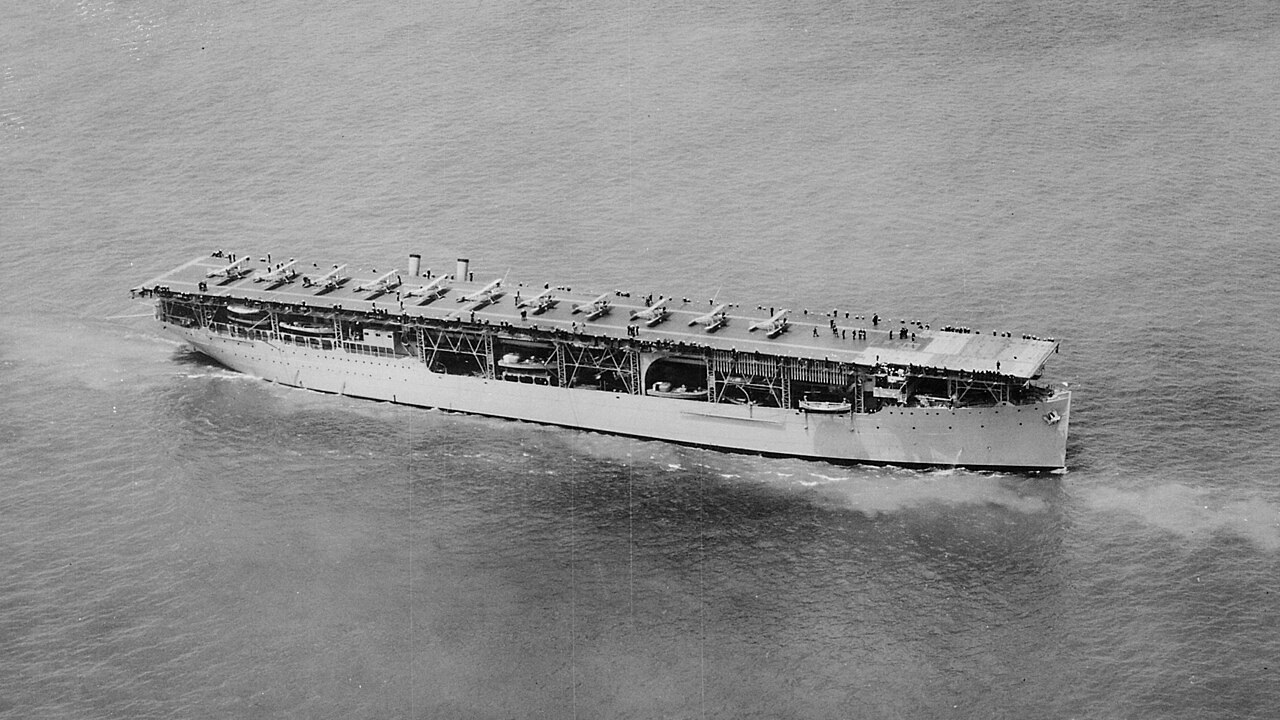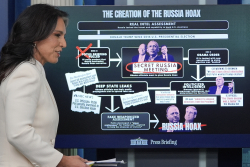
Remembering the Legendary USS Langley (CV-1/AV-3)
The lessons learned from the Langley’s decade of carrier flight operations in the interwar period directly influenced the design of subsequent, more advanced carriers of that era.
What began as a flight of fancy on the part of the interwar United States Navy, the USS Langley (CV-1/AV-3), one of America’s earliest aircraft carriers, would become the basis of the single most important warship platform in modern US naval history. Originally built as a collier—a type of cargo ship built to carry coal—named the USS Jupiter, the ship was later converted into an experimental platform for testing naval flight operations.
Langley was commissioned in 1922 and served as a vital testbed for carrier tactics, pilot training, and aircraft handling at sea—laying the groundwork for the powerful carrier fleets that would dominate the High Seas during the Second World War.
At the time, few in the Navy much understood, let alone appreciated, the importance of the aircraft carrier. But the degradation of America’s surface warship fleet in the wake of the Pearl Harbor surprise attacks by the Imperial Japanese Navy (IJN) forced the Americans to get creative and rely more heavily on their carrier fleet, especially in the Pacific Theater of the Second World War.
The Langley Had Humble Beginnings
The Langley’s journey to being the most important prototype ever designed by the US Navy was an unlikely one. As noted above, the ship was initially conceived of as a Proteus-class collier named the USS Jupiter (AC-3), designed to transport coal for the Navy’s steam-powered warships.
Laid down on October 18, 1911 at the Mare Island Naval Shipyard in Vallejo, Calif., with President William H. Taft in attendance, Jupiter was launched the following year on August 24, and commissioned a year thereafter on April 7, 1913.
Jupiter was the Navy’s first turbo-electric-powered ship, featuring an innovative propulsion system designed by William Le Roy Emmet, which included two electric motors driven by a Curtis turbine and alternator set. This system allowed for a top speed of 14 knots (16 miles per hour) and represented a significant engineering advancement. Thanks to the innovative design of the new engine, there were fewer machines onboard, reducing the weight—and therefore costs—of the Jupiter significantly.
The collier had an impressive service record in its own right. It supported US forces on the Mexican Pacific coast during the 1914 Veracruz Crisis. The Jupiter also became the first vessel to transit the Panama Canal from the Pacific to the Atlantic on Columbus day that same year. The ship conducted cruises in the Atlantic and Gulf of Mexico during the First World War, under the auspices of the Naval Overseas Transport Service. Indeed, the Jupiter made several intense voyages to France, including transporting the first US aviation detachment to England in June 1917.
The impressive collier was decommissioned at Hampton Roads, Virginia, on March 24, 1920. But that was merely its first lifetime. The second life began almost as quickly as the first ship was decommissioned.
The USS Langley (CV-1) Was Built from the Jupiter
A month after her decommissioning, the Navy renamed the boat as the USS Langley, and ordered her conversion into a prototype aircraft carrier at the Norfolk Naval Shipyard. The ship’s large coal holds were accordingly repurposed into hangars for early naval aircraft.
Because the Langley was classified as an experimental boat, it was exempt from the limitations of the 1921 Washington Naval Treaty. This would turn out to be a blessing, as the Navy could experiment with this craft and learn about how best to deploy this ship in the coming war. Langley was designed to carry up to 36 aircraft and featured a full-length wooden flight deck.
Technical specifications post-conversion included a standard displacement of 12,700 long tons. It was powered by its original turbo-electric system, and could achieve 15.5 knots (17 mph) and had a range of 3,500 nautical miles (4,027 miles) at ten knots (12 mph). The crew size grew to 468 officers and men, and while unarmed in its early carrier role, it focused on aviation facilities.
On October 17, 1922, Lieutenant Virgil C. Griffin made the first carrier takeoff in a Vought VE-7 while the ship was anchored in the York River, Virginia. Nine days later, on Oct. 26, Lieutenant Commander Godfrey de Courcelles Chevalier executed the first landing in an Aeromarine 39B. The first catapult launch on November 18, 1922 occurred. These events, conducted both at anchor and underway, were a vital early test of the feasibility of operating aircraft from ships.
As per its designation as an experimental prototype, the Navy pursued a number of creative innovations during the ship’s development. In one instance, the Navy went so far as installing a carrier pigeon house onboard, intended as a backup communication method. Unsurprisingly, however, the pigeons proved unreliable during exercises and were abandoned shortly thereafter.
Throughout the 1920s and 1930s, the Langley served as an unarmed testbed for deck and flight operations, contributing immensely to the development of carrier tactics. Under Captain Joseph Mason “Bull” Reeves in 1925, for example, the ship pioneered the tactic of dive-bombing during fleet maneuvers. This tactic would prove key during the great sea battles with the IJN in the Pacific Theater.
The lessons learned from the Langley’s decade of carrier flight operations in the interwar period directly influenced the design of subsequent, more advanced carriers of that era, like the USS Lexington, USS Saratoga, and USS Ranger, all of which featured wider, longer, and more robust flight decks.
The Langley’s Final Lease on Life
The Langley was once again decommissioned on October 25, 1936, as newer and better equipped carriers entered service. Again, though, the ship found a third lease on life when she was converted into a seaplane tender at Mare Island Navy Yard. CV-1 was redesignated as AV-3 on Feb. 26, 1937.
As AV-3, the Langley served as the Aircraft Scouting Force, operating from bases like Seattle, Sitka, Pearl Harbor, and San Diego. It was briefly deployed to the Atlantic Fleet from February to July 1939 before joining the Asiatic Fleet at Manilla on September 24 of that year.
In the aftermath of the Japanese attacks on Pearl Harbor, Langley found herself anchored off the Philippines. It quickly departed for Balikpapan the day following the Pearl Harbor attacks against Hawaii. She then assisted with key anti-submarine patrols from Darwin, Australia, until January 11, 1942.
From there, Langley was loaded with 32 P-40 fighters and the US Army Air Forces personnel at Fremantle, joining a convoy bound for Java.
On February 27, 1942, approximately 75 miles south of Tjilatjap, Java, Langley was attacked by 16 Mitsubishi G4M “Betty” bombers from the Japanese 21st and 23rd Naval Air Flotillas. In the seas south of Java, Langley sustained five direct hits and three near misses—causing fires, loss of steering, and a ten-degree list to port. With 16 crewmen killed and the vessel inoperable, the crew scuttled the legendary ship. Escorting destroyers USS Whipple and USS Edsall sunk the iconic Langley with gunfire and torpedoes thereafter to prevent capture by the Japanese.
All 32 of the P-40 aircraft onboard the Langley were lost.
America Needs Another USS Langley Today
The USS Langley is probably the most important prototype vessel that was ever built for the modern US Navy. Without it, it is likely that it would have taken far longer for the Americans to perfect the art of carrier-based warfare.
Sadly, today, the innovative nature of the US Navy seems to be stagnating. In the age of anti-access/area-denial (A2/AD) capabilities, there are no real attempts by the Navy to develop a similarly dynamic and next-level warship that will totally upend the way sea battles of the future are fought the way they did more than 80 years ago with USS Langley.
The age of the carrier is over. But Langley deserves a high place of remembrance for the good it did in shaping the last several decades of US naval warfare strategy.
About the Author: Brandon J. Weichert
Brandon J. Weichert, a Senior National Security Editor at The National Interest as well as a contributor at Popular Mechanics, who consults regularly with various government institutions and private organizations on geopolitical issues. Weichert’s writings have appeared in multiple publications, including the Washington Times, National Review, The American Spectator, MSN, the Asia Times, and countless others. His books include Winning Space: How America Remains a Superpower, Biohacked: China’s Race to Control Life, and The Shadow War: Iran’s Quest for Supremacy. His newest book, A Disaster of Our Own Making: How the West Lost Ukraine is available for purchase wherever books are sold. He can be followed via Twitter @WeTheBrandon.
Image: Wikimedia Commons.
The post Remembering the Legendary USS Langley (CV-1/AV-3) appeared first on The National Interest.

















